Budgerigars
Contributions, research and write up by Sheryl & Israel. Page is a work in progress.

The word "budgie" is a popular abbreviation for the word "budgerigar", the name given to the pretty little green parakeet native to Australia (see photo at left). In the wild, budgies are generally light green, with the occasional yellow mutation seen, and between 5-7 inches long.
Over the years these birds have been domesticated, taken to other countries and, thanks to mutations and colour absences, there are now many colours and varieties. In addition, they have been bred for show, with larger birds becoming more desirable. The result is a huge number of different colours.
However, with all of these variations, the budgie is still a very beautiful bird, popular as both a pet and as a showbird. Many of our club members keep budgies.
The following information covers various aspects of both colour variety and information about keeping budgies.
Sexing
It is usually very easy to determine whether a budgie is male or female. The small area above a budgie's beak that contains the nostrils is called the "cere". In fully-grown males, the cere is clearly blue. In females, it is a rich brown.
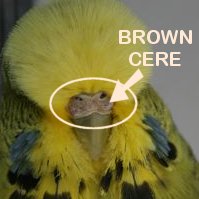
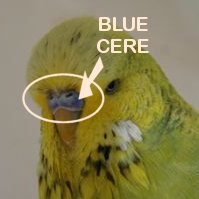

When budgies first leave the nest it can be harder to tell. Males' ceres can appear purple, and females' light blue to white, but these generally change to their proper colour within the first couple of months. In pied and albino varieties, the cere can remain pinkish or pale, making it harder to identify the gender, but behaviour often gives it away!
Varieties of Budgerigar

From the original light-green budgie have come many different-coloured birds. These began with simple mutations, such as the absence of a usual colour, for example yellow which gave rise to the blue series birds. Over the years these mutations have been bred true and more discovered until now there are over 30 varieties recognized throughout the bird-keeping world.
The varieties of budgies are usually organised via colour / mutation, however when showing it is the features and marking that are important, not so much the colour. Hence when breeding one needs to determine if you are going to be breeding just for colour, or trying to produce show quality birds.
Budgies have two main base colours - yellow and white. When the base colour is combined with the natural melanin pigmentation on their feathers their colour becomes green and blue respectively, which gives rise to the main two colour series of budgies (being of course green-series and blue-series). All of the other mutations act upon these (such as the darkening factor for example which gives the six base colours for the two series) to give rise to the wide variety of budgies that are now available today. For an in-depth look at the different varieties of budgie colours and their genetics, there is an article on Budgie Genetics in the articles section of this website.
Below are examples of some of these varieties:
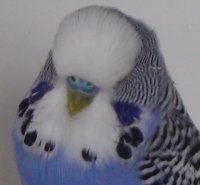 |
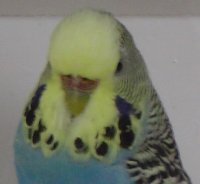 |
 |
| Male Violet Budgie | Female Yellow-face II Violet Budgie | White Lacewing Budgie |
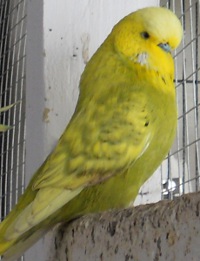 |
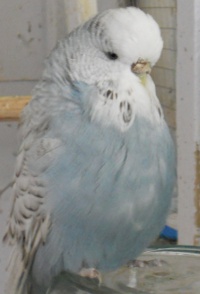 |
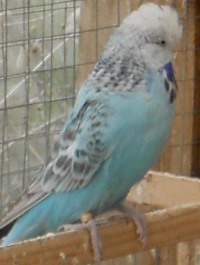 |
| Spangle Opaline Grey-green Male | Spangle Grey Hen | Cinnamon Opaline Skyblue Budgie |
Breeding
As mentioned earlier, the most important consideration when breeding budgies (like many other birds in fact) is to decide if you are breeding for show quality or for colour as the two are not always compatible. If you are breeding for colour, then with a basic understanding of the matching expectations the decision of which birds to pair should be easy. If you are breeding for show then it is usually a good idea to pair your best birds together in order to carry over the desirable traits (see also an article on Line Breeding).

layer on the bottom.
Usual practice for breeding budgies is to do so in breeding cages, where the nest boxes are attached to the outside of the cage. The nature of the nest boxes allows easy access to check on the eggs / young, but care must be taken to make sure that the parents are out of the nest box before removing the inside layer and before putting it back, lest unwanted accidents occur. Usually a scraping noise on the outside is enough to get the parents to move back out into the breeding cage, and while a temporary barrier can be lowered down over the entrance to stop them trying to go back in while the inside layer is out of the nest box, visually checking the location of the parents before returning the inside layer works just as well. It has been known for the temporary barrier to be accidentally left in, in which case the parents are unable to return to their young to feed them.
Budgies do not build their nests as other birds do (like canaries for example), instead quite happily laying their eggs in a dark hollow (aka nest box) layered with small woodchips/wood shavings that has been provided for them. In fact if nesting material (like twine) is put into their nest box they will toss it out of the nest before starting to lay.
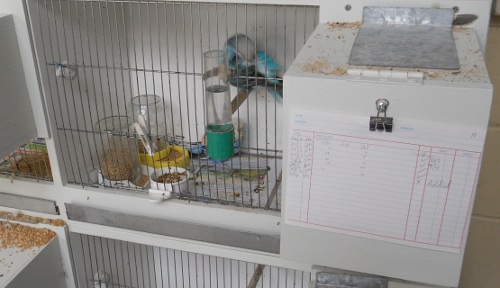
|
|
Budgie breeding cage. The nest box is on the left. The piece of metal sitting on top can be used to isolate the nest box from the cage if needed by being slid in between the two. |